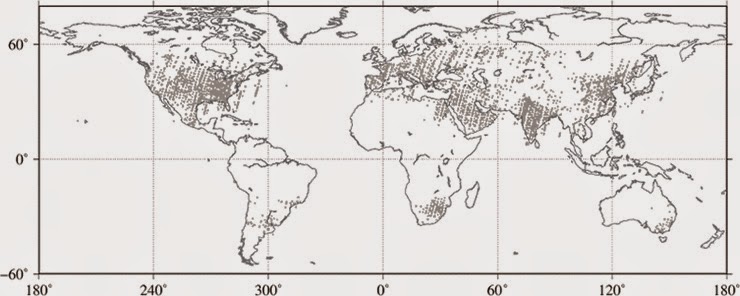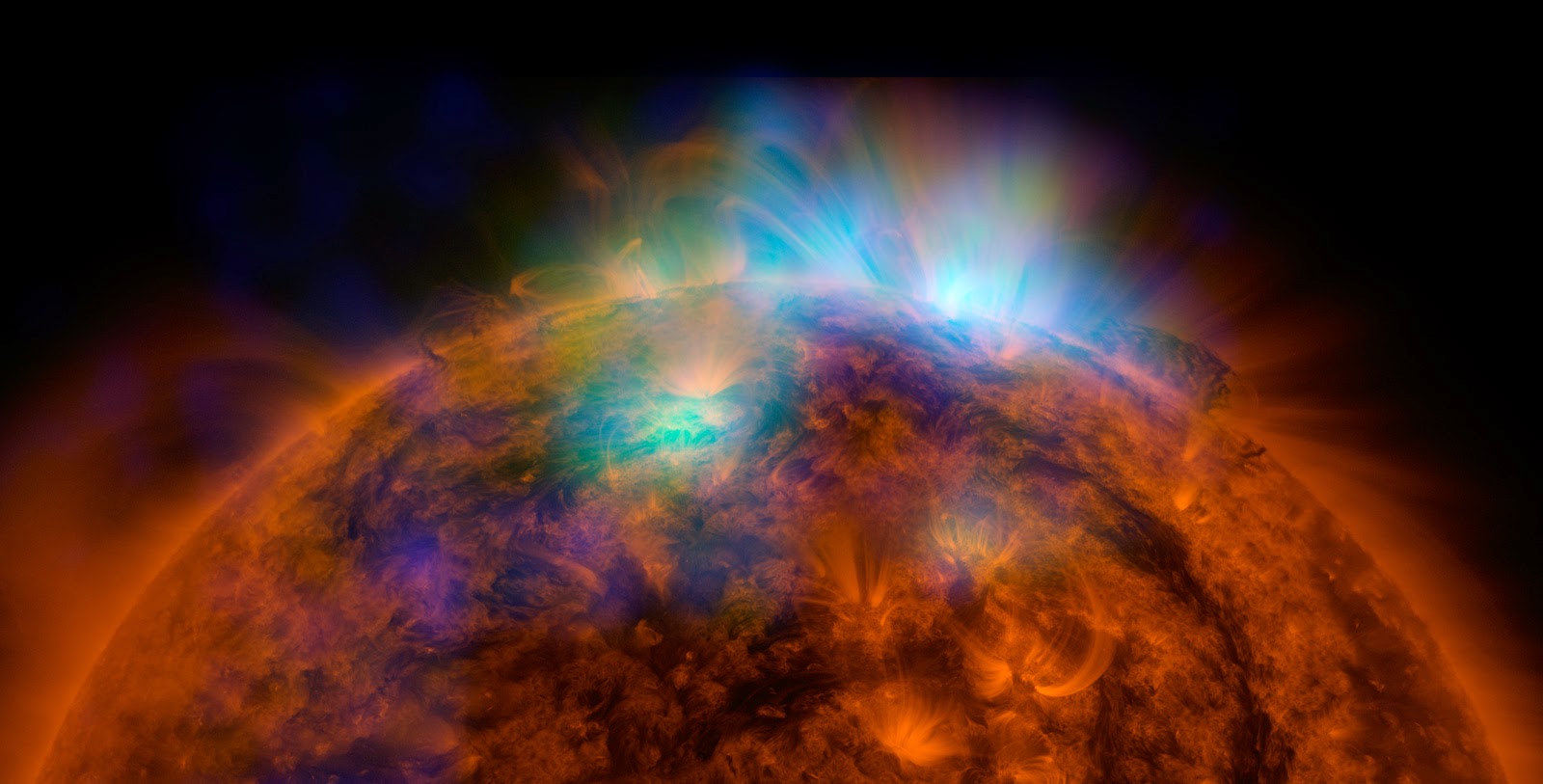JAXA - IBUKI (GOSAT) Mission logo.
December 25, 2014
"IBUKI" (GOSAT) Satellite's Historically Unprecedented Observation of Anthropogenic CO2 Emissions of Mega-City Regions from Space
The Greenhouse gases Observing SATellite "IBUKI", developed jointly by the Ministry of the Environment (MOE), the National Institute for Environmental Studies (NIES), and the Japan Aerospace Exploration Agency (JAXA) is the world's only satellite designed specifically to monitor greenhouse gases from space. The satellite has continued to fulfill its main mission in monitoring atmospheric carbon dioxide (CO2) and methane concentrations from space to improve the accuracy of sink/source estimates, and achieve its target to contribute to precision refinement for the ongoing elucidation of carbon cycles, since its launch on January 23, 2009.
CO2 concentrations in mega-cities and their surroundings were analyzed for the three and half years from June 2009 to December 2012, based on the observational data acquired by "IBUKI", indicating the tendency for higher CO2 concentrations in mega-cities than those in their surroundings. Furthermore, positive correlations were shown between differences in CO2 concentrations and the concentrations estimated from data for fossil fuel consumption. These results indicate that "IBUKI" observations have the potential to enable us to detect enhanced CO2 concentrations with their origin in fossil fuel consumption for mega-cities. These studies demonstrate the potential utility of satellite observation of CO2 concentrations as a tool for monitoring greenhouse gas emissions (inventory) from fossil fuels.
With the progress in studies to monitor large point CO2 sources by satellite observation and other methods, these results will be applied to current and forthcoming research projects involving "IBUKI" and its successor - GOSAT-2 - to be launched in fiscal year 2017.
1. Overview of the data on anthropogenic CO2 concentrations from "IBUKI" (GOSAT)
Carbon dioxide (CO2) is a greenhouse gas the atmospheric concentration of which has increased by 40% when compared to pre-industrial times, as a result of anthropogenic activities. Fossil fuel consumption in large fossil fuel power plants and mega-cities are assumed to be the main sources of anthropogenic CO2 emissions. The CO2 emission rates in these areas should be accurately evaluated to monitor greenhouse gas emissions.
A validation study has shown that the greenhouse gases observation sensor, "TANSO-FTS" onboard "IBUKI" observes column-averaged CO2 concentrations (hereinafter, "CO2 concentrations") to a precision (random error) of 0.5% (approximately 2 ppm) in comparison to the data acquired from ground-based observations. This study investigated the detectability of enhanced CO2 concentrations due to anthropogenic emissions, by satellite observation.
CO2 concentrations acquired by "IBUKI" comprise not only those pertaining to anthropogenic emissions but also encompass photosynthetic uptake and respiration-release by plants; emissions due to forest fires; and sink/source by ocean. These processes should be considered when interpreting the information on anthropogenic CO2 emissions from the CO2 concentrations acquired by "IBUKI". This study estimated CO2 concentrations due to anthropogenic activities from observational data by "IBUKI" by the method described below.
Firstly, the spatiotemporal distribution of CO2 concentrations originating from anthropogenic CO2 emissions are estimated using the data for anthropogenic CO2 emission rates from fossil fuel consumption (emission inventory) - a value based on the data for nighttime lights on the earth's surface as observed by satellite, as well as the information from the database for fossil fuel power plants and an atmospheric tracer transport model. Subsequently, on the basis of this estimate, the observational data for CO2 concentrations acquired by "IBUKI" are classified into two categories: data including contamination by anthropogenic CO2 emissions (top panel in Figure 1) and those not including this contamination. The individual observational data sets including anthropogenic contamination are subtracted using averaged values for the data not including contamination, and values for CO2 concentrations from forest fires and plant activities are then subtracted from the data. These calculations produce the figures for anthropogenic CO2 concentrations using observational data from "IBUKI" (bottom panel in Figure 1).
2. Results of anthropogenic CO2 concentration estimates from "IBUKI"
Figure 1 shows global distribution of anthropogenic CO2 concentrations estimated from observational data from "IBUKI". Data including contamination by anthropogenic CO2 emissions is mainly concentrated on the Northern Hemisphere, especially in mega-city regions (top panel in Figure 1).
Figure 1
Graphics above: (Top) Observational points of "IBUKI" where anthropogenic CO2 concentrations are higher than 0.1 ppm for June 2009 and December 2012.
(Bottom) Distribution of anthropogenic CO2 concentrations estimated from observational data acquired by "IBUKI".
(1 deg. grid resolution; only grid with observational data greater than 24 are plotted).
Anthropogenic CO2 concentrations are shown by colors. Red rectangles show the areas listed in Table 1. Three of four regions used in Figure 3 are shown in yellow, green, and blue for, respectively, Japan, East Asia, and North America.
Figure 2
Graphics above: Enlarged views of North America (top) and East Asia (bottom) in Figure 1.
Table 1 A list of regions indicating high concentrations of anthropogenic CO2 emissions derived from "IBUKI" in Figure 1.
* Average figure of anthropogenic CO2 concentration of Japan (scope within yellow pengtagon in the bottom part of figure 1) for past 3.5 years is 0.2ppm.
Regions with higher CO2 concentrations from anthropogenic activities are shown in the bottom of Figure 1 and Figure 2 and summarized in Table 1. The regions in Table 1 can be identified as those with dense populations or industrial zones with fossil fuel power plants and developments of oil and gas fields.
Figure 3 shows the relationships between anthropogenic CO2 concentrations derived from the emission inventory and the observational data acquired by "IBUKI" in four regions (Japan, East Asia, North America, and the globe), as shown in the bottom of Figure 1. Key aspects relating to Figure 3 are as follows:
1. Anthropogenic CO2 concentrations derived from the emission inventory and the observational data acquired by "IBUKI" show high correlations in "globe" and "North America"; and the differences in concentration measurements fall within the range of observational error for "IBUKI".
2. Good correlations are also found in the concentrations for "East Asia"; however differences exceed the range of observational error for "IBUKI" for some measurements.
3. While there is a correlation between the concentrations for "Japan", estimation errors for anthropogenic CO2 concentrations from "IBUKI" are significant due to a paucity of observational data.
These results suggest that "IBUKI" has the potential to detect enhanced CO2 concentrations resulting from fossil fuel consumption in mega-cities.
Figure 3
Graphic above: Relationships for anthropogenic CO2 concentrations derived from emission inventory and "IBUKI" for the globe (left), North America and East Asia (center), and Japan (right). Anthropogenic CO2 concentrations derived from "IBUKI" were classified for each 0.2 ppm of concentrations from inventory; average and standard deviation was then calculated in each class. This study excluded data with concentrations from inventory greater than 1 ppm.
Notes:
1. Column-averaged concentration of CO2
The mixing ratio of CO2 molecules relative to that of dry air, from the earth's surface to the upper extremities of the atmosphere.
2. Anthropogenic CO2 concentrations estimated from inventory
Inventories of CO2 emissions from fossil fuel consumption and forest fires, a biospheric model, and an atmospheric tracer transport model were used in this study to estimate anthropogenic CO2 concentrations by inventory.
3. Inventory of CO2 emissions by fossil fuel consumption
ODIAC (Open-sources Data Inventory for Anthropogenic CO2) was used in this study as inventory for CO2 emissions by fossil fuel consumption. Oda and Maksyutov, Atmos. Chem. Phys., 11, 543-556, 2011.
4. Database of fossil fuel power plants
CARMA (Carbon Monitoring for Actions) is used in ODIAC as the database for fossil fuel power plants:
http://www.carma.org/plant
5. Inventory of CO2 emissions by forest fires
GFAS (Global Fire Assimilation System) was used in this study as inventory for CO2 emissions by forest fires. Kaiser et al., Biogeosciences, 9, 527-554, 2011.
Reference:
Greenhouse gases Observing SATellite "IBUKI" (GOSAT):
http://global.jaxa.jp/projects/sat/gosat/
Images, Graphics, Text, Credits: Japan Aerospace Exploration Agency (JAXA)/National Institute for Environmental Studies (NIES)/Ministry of the Environment, Japan (MOE).
Greetings, Orbiter.ch















%2Blogo2.jpg)















.jpg)










